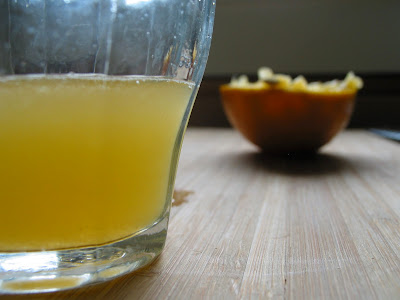The other day, my lovely mother sent me a citrus-y surprise from Florida. She's probably more obsessed than even I am for sniffing out backyard fruit that may be going unappreciated. It's where I get it from. Well, a generous neighbor of hers allowed her to take some oranges that were probably good one day, but had reverted back to it's root stock, and were now, according to her, seedy and sour. My guess is that root stock is the Florida sour orange, which is none other than the Seville, or bitter orange, the classic marmalade orange. Also, the classic Triple Sec orange.
I really didn't want to make marmalade (some peels were mottled brown) or Triple Sec (I still have some from last year). I was stalling, the huge bowl of oranges sitting in the fridge, patiently waiting. Today it hit me: the sour taste of these oranges seemed a natural mixer for cocktails, so, very simply, I juiced them, then added a small bit of sugar, and canned the juice for drinks this summer. Although, I won't be waiting to use this. I'll wager I'll be having a whiskey sour very shortly.
To be honest, I didn't know exactly what to call this. Sour mix, as you may know, is a cocktail mixer that is made with lemons, limes, and simple syrup. For the masses, this means horribly sweet fake stuff, and for mixologists of fancy cocktails this means hand-squeezed juices mixed with sugar and water. I will always opt for fresh squeezed, but when you have a load of gorgeous seville oranges on your hands, this is what you can do to drink them through out the year. I think these would make a fine margarita, as well!
Sour Mix:
Four cups of Florida Sour or Seville orange juice*
1 cup of sugar
Add the two in a large non-reactive pot. Stir to dissolve the sugar. Sterilize two pint jars, and one half-pint for the extra bit to stash in the fridge. Bring mixture to a boil. Ladle into hot jars. Process for ten minutes.
*I realize that not many folks have access to these fruits. You can probably approximate by using a mix of lemons and limes, with an orange or two thrown in. I used a 1:4 ratio of sugar to fruit, which I think was perfect for my tastes, but you may want to add more sugar. Taste it as you go, and you should be fine.
But wait--there's more! Please don't throw out those peels! I scraped the cups and saved the pulp to make citrus pectin stock. And the peels will be turned into candied bits. If you are lacking at all for inspiration, please look to Local Kitchen's amazing compendium of citrus uses. You will never throw out another peel.










